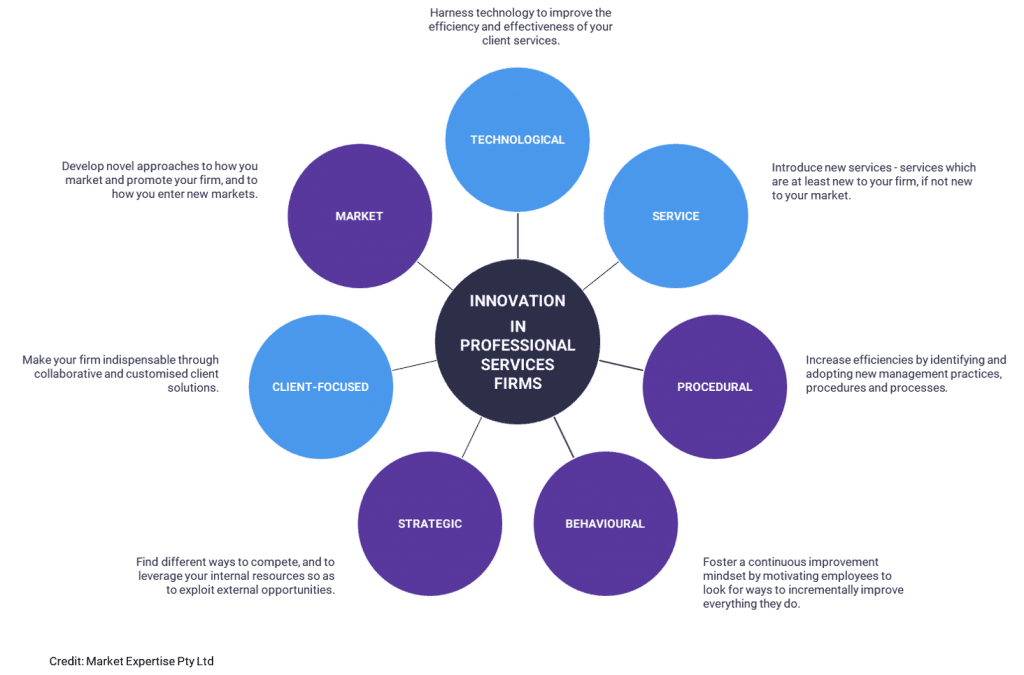Every professional services firm claims to be innovative (would any firm admit to being regressive?), but how many really are?
The good news is, every firm can (and should) be innovative. Most simply don’t understand what innovation means, or how it applies to professional services firms.
Let’s demystify innovation in professional services firms. We’ll start by understanding why innovation is important in a professional services environment.
The case for professional services innovation
Most professional services categories – law, accounting, management consulting, recruitment… – are highly competitive. Even worse, many of the services offered by these firms are now commoditised. There is little to distinguish one firm from another, or one practitioner from another.
In this environment, innovation is what:
- differentiates one firm from the rest
- enables one firm to command a price premium while others are under price pressure
- makes one firm significantly more profitable than its competitors
- builds client loyalty and creates a seemingly impenetrable barrier to switching
- a firm needs to attain and maintain a competitive advantage.
Importantly, in a tendering situation, innovation – of strategy, methodology, pricing… – is increasingly what’s needed to win.
Innovation stripped bare
In a professional services environment, innovation takes two forms: it’s either internally- or externally-focused.
- Internal innovation benefits the firm by improving the way it does business
- External innovation benefits the firm’s clients.
In 2007, academics at the University of Western Australia embarked upon research into what constitutes innovation in professional services firms. The study built upon 2004 UK research and concluded that in professional services firms there are seven dimensions of innovation.
Four of these dimensions are internal, and three are external.

Internal Dimensions
- Strategic Innovation refers to how a firm competes, leverages its resources, and creates a competitive advantage. Increased competition, new market entrants, and the changing workforce are among the drivers for this dimension.
- Behavioural Innovation, the key to incremental and continuous improvement. Behavioural innovation is not occasional or one-off – it’s constant, carefully fostered. Behavioural innovation is achieved when a firm creates an open-minded culture, one which embraces new ideas and encourages employees to seek out new and improved ways of performing even the most menial of tasks. Behavioural innovation doesn’t achieve a ‘big bang’ – it’s cumulative and therefore is something of a stealth strategy. This dimension is a high priority for many professional services firms and is evidenced by firms empowering employees to take measured risks and incorporating innovation criteria in performance appraisals.
- Market Innovation references a firm’s approach to entering and exploiting new markets – how it goes to market and promotes its brand and business. According to the CommBank Business Insights Report: Professional Services 2018, only 26% of professional services firms are investing in sales and marketing approaches, indicating this dimension is a low priority for most firms (and an opportunity for some).
- Process Innovation aids organisational efficiency through the adoption of non-technology-based new and best practice processes, procedures and techniques. It can be driven by quality, compliance and regulatory demands, as well as being a reaction to declining margins.
External Dimensions
- Technological Innovation is seen as a means of improving service delivery – for example, a firm’s use of technology to service regional, remote or overseas clients.
- Service Innovation involves the introduction of new (or at least new to the firm’s market) services. Client demands, coupled with increased competition, are driving more firms to introduce new services at a rapid rate, and to invest time and capital in exploratory ventures, both independently and jointly.
- Client-Centric Innovation is created in collaboration with a client. As such, this type of innovation is original, though it can later be reproduced, repackaged and re-sold. On this dimension, firms tend to be either occasionally innovative, or industry leaders in the design and development of innovative solutions.
Once firms understand the seven dimensions of innovation in professional services, they can identify which dimensions represent the best opportunities for them, and their clients.
Words of Advice
- Don’t be misled into thinking all innovation has to be disruptive. It doesn’t. In fact, most isn’t. Behavioural innovation might not sound sexy but it’s the key to incremental and continuous improvement.
- Engage your workers as they’re the people who are best placed to identify opportunities to make incremental improvements. Process innovation will not only make your business more efficient, it will enable your people to be more productive.
- Don’t make assumptions on behalf of your clients – engage them in the process. Where do they see the best opportunities? What are their pain points? How might you make their lives easier? What services do they wish you could provide? What services do they need you to provide?
- Leave your ego at the door. Yes, it would be cool to create a chatbot but should that really be your priority? If there’s no demand, no real benefit, you’re wasting time and money.
- Consider your motivation. Are you reacting to the external environment, or proactively preparing for the future? This will certainly influence how you prioritise opportunities.
- Document your decision-making processes and make an effort to track and record the impact of your innovations, however small. The time will come (if it hasn’t already) when you will be asked to explain your firm’s approach to innovation, and to give examples of how it innovates to benefit clients, and achieve operational efficiencies.
- If your professional services firm decides to appoint an innovation partner or leader, hold that person accountable. Too often, firms give fee earners additional responsibilities (continuous education, innovation, pro bono…) and then nothing happens. Make innovation a regular agenda item at leadership meetings and provide periodic updates to employees.






